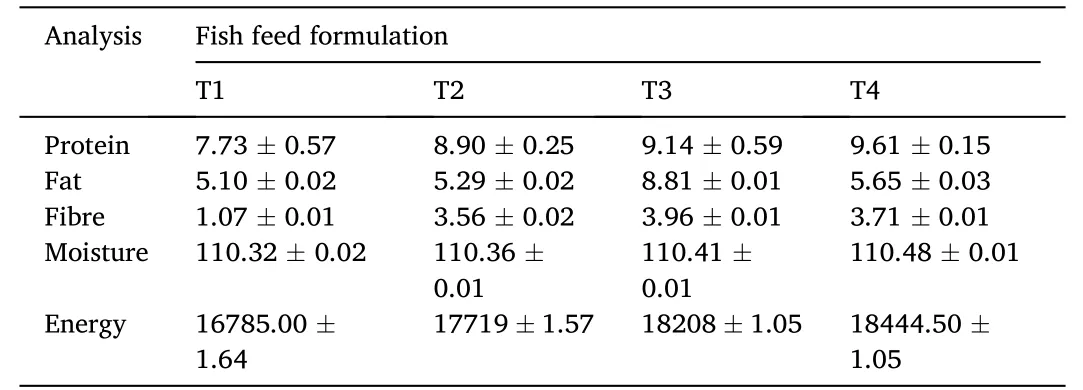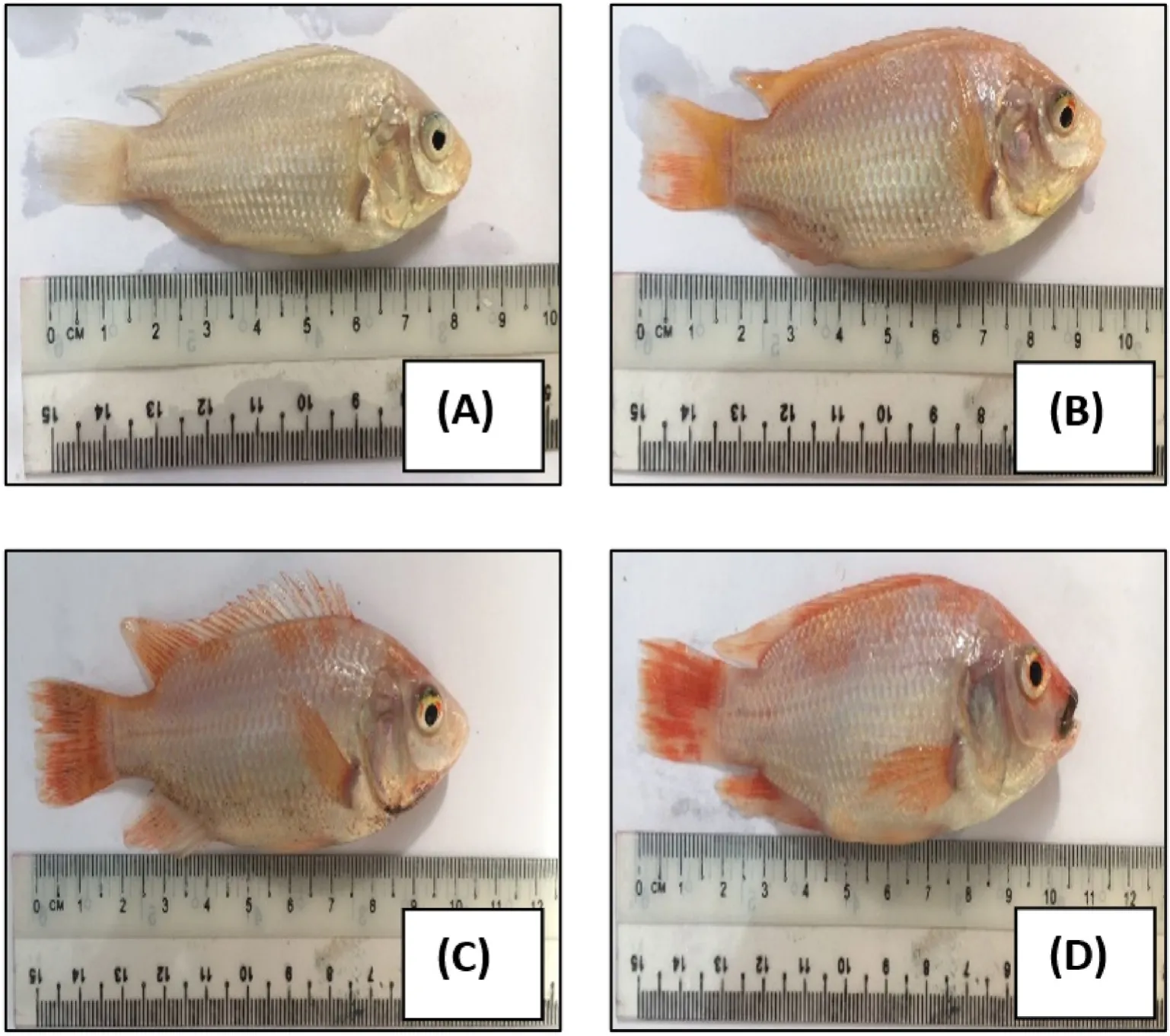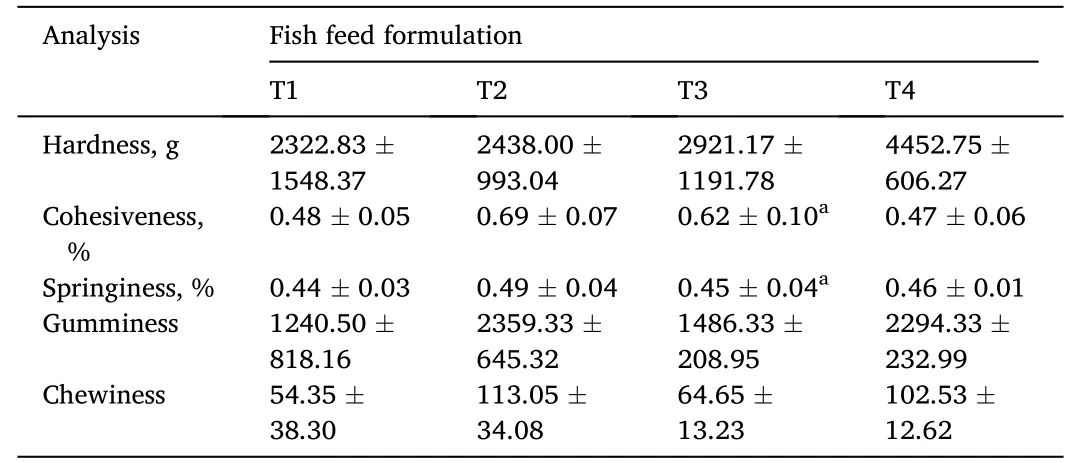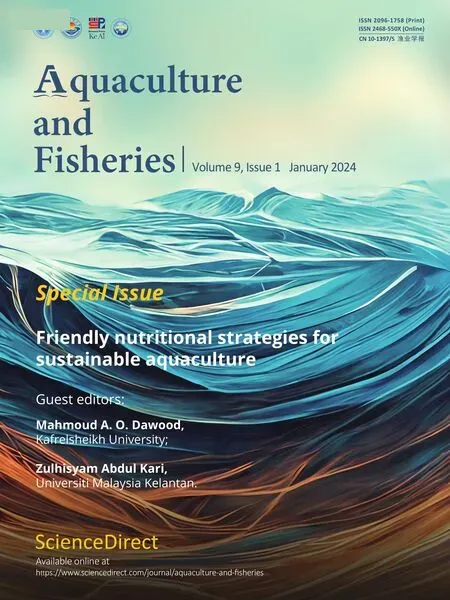Effects of dietary astaxanthin enrichment on enhancing the colour and growth of red tilapia,Oreochromis sp.
Zuharlida Tuan Harith,Suniza Mohd Sukri,Nor Fatin Syuhada Remlee,Fatin Nursabriena Mohd Sabir,Nik Nur Azwanida Zakaria
Faculty of Agro Based Industry,Universiti Malaysia Kelantan Jeli Campus,Jeli,Kelantan,17600,Malaysia
Keywords: Oreochromis sp .Astaxanthin Haematococcus pluvialis
ABSTRACT The aim of this research was to examine the effects of dietary inclusion of astaxanthin from Haematococcus pluvialis in commercial fish feed on the colour and growth of red tilapia,Oreochromis sp..A 6-week feeding trial was conducted at concentration of astaxanthin at 0% (T1),4% (T2),8% (T3) and 12% (T4) in feed formulation to examine the growth performance,colour pigmentation on skin,texture analysis and carotenoid contents.Results showed an increment of certain growth parameter in fish fed with astaxanthin enriched diet.Increased in weight gain (WG),protein efficiency ratio (PER) was obtained in fish fed with astaxanthin enriched compared with control.All treatments with astaxanthin-enriched provided higher redness (a*) to skin than negative control that directly influence the colour of the fish.It can be concluded that inclusion of astaxanthin from green algae into commercial fish feed can be used as an alternative natural carotenoid source in Oreochromis sp.diets to ensure good pigmentation,hence improving the skin colour for more appealing and subsequently increase the market value of the fish.
1.Introduction
The red tilapia (Oreochromissp.) is highly in demand due to many factors such as its high flesh quality,main source of protein and its attractive colour;which makes the fish worth the high price (Arous et al.,2014).However,one of the main problems associated with caged tilapia in the current market are its unattractive pale colour due to lack of carotenoid pigment in their skin and flesh,specifically the astaxanthin.Animals are unable to synthesis carotenoids de novo,and the carotenoids present in the animals skin and flesh are acquired through their diet (Galasso et al.,2017).For example,wild tilapia obtains astaxanthin requirements through ingestion of abundantly present microalgae in the water,mainly fromHaematococcus pluvialis.However,when fishes are removed from their natural environment and placed in a cage,adequate and appropriate diet must be provided to ensure their excellent health and growth.An artificial diet enhances the availability of all the nutrients required by the fish,including astaxanthin (Carvalho&Caramujo,2017).
Astaxanthin is a xanthophyll carotenoid that can be found in a variety of microorganisms and marine animals (Higuera-Ciapara et al.,2006).It is extensively used as an additive in formulated aquafeeds to promote and enhance the coloration of muscle in salmon and shrimp.The primary function of astaxanthin is to provide the beneficial reddish-orange colour in caged fish since they do not have access to natural sources of carotenoids.The use of astaxanthin in the aquaculture sector is important for pigmentation and consumer appeal,and well as an important dietary component for sufficient growth and reproduction(Higuera-Ciapara et al.,2006).Furthermore,the United States Food and Drug Administration (USFDA) has authorised the use of astaxanthin as a food colourant in animal and fish feeds (Pashkow et al.,2008).
Recently,the availability of affordable and high-quality fish feed has been a major problem in the development of Malaysia’s aquaculture industry.Fish growth and survival rate rely on the type of feed,feeding frequency,feed admission and the fish’s ability to ingest the nutrients.When fishes are moved from their natural habitat to an artificial one,they require adequate nutrition to maintain their good health and growth.An artificial diet with astaxanthin enriched fish feed provides the fish with all of the nutrients that they require.In this study,astaxanthin was extracted from the green algae (H.pluvialis),which is one of the best sources of natural astaxanthin (Ranga Rao et al.,2010).
Consumer’s decisions to purchaseOreochromissp.fish were influenced not only by the price,but also by freshness,the intensity of colour in the skin and flesh of the fish,and taste.These factors generally determine the market value of red tilapia fish.Despite the fact that it is called a red tilapia,the flesh of the red tilapia sold in the market nowadays is in white and pale in colour,and not attractive as it supposed to be.Hence,the colour of the red tilapia is one of the important parameter that must be maintained and improved to ensure it is appealing and influence the purchasing decision by the consumer.Therefore,this study was designed to incorporate astaxanthin fromH.pluvialisinOreochromissp.feed to increase the aesthetic of the fish by increasing the orange pinkish pigmentation as well as their health.
2.Materials and methods
2.1.Ethics statements
This study was carried out at laboratory animals and fish hatchery facility at Universiti Malaysia Kelantan Jeli Campus,Malaysia.It was approved by the Animal Ethical Committee of Universiti Malaysia Kelantan.
2.2.Experimental diets
Fish feed enriched with astaxanthin extract from green algae(H.pluvialis) were prepared in this study.The treatments consisted of four diets,evaluated in triplicate for 6 weeks.The diet without astaxanthin supplementation was considered as the control diet (T1).Meanwhile,the diets of other three treatments were enriched with commercial pellet with different percentage of astaxanthin 4% (T2),8%(T3) and 12% (T4) (Table 1).Commercial fish feed were used and reformulate by adding astaxanthin as enrichments for the fingerling’s tilapia throughout this experiment.Commercial feed used in this study composed of fish meal,soybean meal,rice bran,grits,vitamins and minerals.The feed was grounded and mixed with astaxanthin at different concentration before pelletizing at approximately 1–1.5 cm in size.The feed was dried at 50◦C for 24 h and kept in closed container prior usage.The chemical analysis of experimental diets including protein,fat,energy and moisture were performed in accordance to standard AOAC protocols (AOAC,2012).

Table 1 The treatments of the experiments.
2.3.Fish and culture condition
Three hundred and sixty of healthyOreochromissp.fingerlings with an initial mean weight of 10.0 ± 1.0 g fingerlings were obtained from the local hatchery in Jeli,Kelantan.All fingerlings were acclimatized for seven days to prevent stress and fed commercial pellets (TP0,Star Feedmills,Thailand contain 32% crude protein,3% crude fat) before diet treatments.The fingerlings were then distributed randomly in twelve aquariums with a capacity of 100 L for 30 fingerlings/tank cultivation.Feeding of fish were performed manually three time a day(0800,1400 and 2000 h) to apparent satiation 7 days a week which lasted for 6 weeks.During the experimental period,dissolved oxygen was maintained above 5.0 mg/L and pH between 5.5 and 7 was monitored daily by using YSI 550.Body weight was recorded weekly.To maintain water quality,detritus,uneaten feed and dead fish were syphoned out of the tank and half of the water were swapped daily.Feeding was stopped 24 h before weighing to reduce stress on fish (Sukri et al.,2016).The number of survival fish and body weight were recordedfor analysis of growth performance.Fish were preserved at -80◦C until further analysis.
2.4.Growth performance
At the end of feeding trial session,fish was individually weighed.Data were collected to identify growth performance of fish.The estimation of percentage of weight gain (WG),survival rate (SR),specific growth rate (SGR),protein efficiency ratio (PER) and fish total length(FTL) were calculated using the formula below;
2.5.Texture analysis
Texture analysis was performed at the end of fish trials.Three fillet samples of each replicate of treatments were evaluated for texture quality.Fish texture profile such as hardness,cohesiveness,springiness,gumminess,chewiness were analyzed using Brookfield CT-3 Texture Analyser.The fillet was cut from head to tail and dorsal to ventral.Fillet samples were placed on the stage of the texture analyser and cylinder probe was used to analyse the texture as prescribed in the protocol: a pre-test speed,a test speed,target value and trigger value were set as 1.0 mm/s,10.00 mm/s,1.00 cm and 5 g,respectively (Sukri et al.,2022).
2.6.Colour analysis
The flesh and skin of fish were evaluated according to Cheng,Sun,Zeng,and Liu (2015) where L* is indicated by lightness,a* is redness and b* is yellowness using CR-300 Chroma meter (Minolta,Osaka,Japan).
2.7.Statistical analysis
The statistical analyses were used software program SPSS (Version 14.0;SPSS) for Windows.All data were analyzed using one-way analysis of variance (ANOVA) to assess the efficiency of the use of astaxanthin in fish diet in order to promote growth and characteristics ofOreochromissp.Duncan’s multiple range test were used as significant differences were found.
3.Results
3.1.Compositional analysis of feed
Table 2 shows compositional analysis of fish feed incorporated with 4% astaxanthin (T2) and control (T1).Generally,increasing the ratio of astaxanthin incorporated into fish feed resulted in increased nutritional values mainly on the protein content.Similarly,the fibre and energy values are increased in the T2 as compared to control.

Table 2 Proximate analysis of the formulation of fish feed enriched with astaxanthin.
3.2.Growth performance
The weight gain,survival rate,specific growth rate,protein efficiency ratio and total length ofOreochromissp.were presented in Table 3.Results show no significant differences were identified in terms of weight gain (WG) among fish fed with different feed formulation.Similarly,protein efficiency ratio (PER) and fish total length (FTL) also indicated no significant difference among the different treatment (P>0.05).Meanwhile,the results of the specific growth rate (SGR) in T1 showed the highest value with significant difference of (P<0.05).Also,survival rate (SR) has significant difference (P<0.05).However,a high level of astaxanthin diet in T4 caused no further increase in survival rate,weight gain and specific growth rate similarly with a previous study on red swamp crayfish by Cheng and Wu (2019).

Table 3 Weight gain,survival rate,specific growth rate,protein efficiency ratio and total length of Oreochromis sp.
As for total fish length,highest total length was red tilapia fed with T3 dietary whist T2 was the lowest.However,a lengthy moment of supplementation may be needed to observe any beneficial effect on growth performance by including astaxanthin in diet (Cheng et al.,2017).
3.3.Colour evaluation
In this study,changes in colour were observed over 6 weeks of feeding trial.Fig.1 shows the differences in colour visually.The results for colour evaluation on skin ofOreochromissp.is done by determination of the values of lightness (L*),redness (a*) and yellowness (b*) as shown in Table 4.Generally,there was no significant difference of lightness found among any experimental groups (P>0.05).Meanwhile,redness and yellowness have significant differences (P<0.05).Meanwhile,the colour intensity (L*) fish skin was significantly higher in T3 than those other treatments.Red chromaticity (a*) was significantly increased by the carotenoid-rich diets,except for T2 which significantly decreased.The redness value in T4 is higher compared to other diet,and it represent in Fig.1 where the intensity of red colour is higher compared to other treatment.There was increment in average values of the b* (yellowness) in the skin ofOreochromissp..However,a high level of astaxanthin (T4) cause no further increase in b* (yellowness).

Fig.1.Colour of Oreochromis niloticus sp.fed with astaxanthin enriched feed.(A) Control,T1;(B) 4% astaxanthin,T2;(C) 8% astaxanthin,T3 and (D) 12%astaxanthin,T4.

Table 4 Colour intensity on skin of Oreochromis sp.. fed diets with different level of astaxanthin after 6 weeks.
3.4.Total carotenoid content
Table 5 shows the overall carotenoid content in both skin and flesh ofOreochromissp..It was observed that the carotenoid contents increased over treatments after receiving dietary astaxanthin.In this study,increased carotenoid content was reported in all groups in line with increasing dietary astaxanthin inclusion.However,no significant difference (P>0.05) were indicated in all diets.

Table 5 Total carotenoid of Oreochromis sp.fed diets with different level of astaxanthin after 6 weeks.
3.5.Fish texture analysis
The texture of fish flesh is an important sensory framework that will determine quality and acceptability for use in high-value products(Bolta,1991).Table 6 shows the results of texture analysis ofOreochromissp.fed with different amount of astaxanthin enriched feed.Based on the data,no significant differences were identified in the hardness,cohesiveness,springiness,gumminess and chewiness of red tilapia fish among all treatments (P>0.05).T4 (12%) shows the highest hardness of the red tilapia fish with a value of 4452.75 g followed by the T3 (8%),2 (4%) and the control with a decrease of 2921.17 g,2438.00 g and 2322.83 g.There was a significant difference in cohesiveness between T4 and the other treatments (P<0.05).T2 (4%) shows the highest cohesiveness as well as the springiness of the red tilapia fish with a value of 0.69 and 0.49 compared to the other treatments.Followed by gumminess and chewiness as well where T2 obtained the highest compared to the other treatments.

Table 6 Texture analysis of the Oreochromis sp.fed diets with different level of astaxanthin for 6 weeks.
4.Discussion
Our present findings indicates thatOreochromissp.fed with different levels of astaxanthin indicated a significant increase in weight gain when compared to control.In addition,higher values of weight gain in T2,T3 and T4 resulted in dietary supplementation of astaxanthin in fish diet may have a beneficial effect onOreochromissp..Oreochromissp.in T3 has higher digestion of feed compared to other treatments.During 6 weeks of feeding,fingerlings in T3 fed more vigorously during feeding period and the most active fish.Although the weight gain increased with increasing astaxanthin content up from T1 to T3,further increasing dietary content up to T4 did not show any additional improvement of the weight gain inOreochromissp..It has been attributed to the reduction of carotenoid digestibility at higher inclusion level.The feed was not adequately absorbed and the excess carotenoid given would be a waste and it will increase cost of production.It was consistent with previous findings on shrimp species.In different study,Cheng et al.(2017) reported that dietary inclusion of astaxanthin could enhance weight gain of pufferfish.
Earlier studies have suggested that dietary astaxanthin can improve weight gain of several fish species,including carp (Jagruthi et al.,2014).Enrichment of astaxanthin sourced fromH.pluvialisis suitable for fish feed and will not harm as compared to synthetically produced.Hussein et al.(2013) reported that the acceptance of microalgae in the tilapia diet reported that the consumption of feed was closely related to the diet of commercial fish feed,suggesting thatOreochromissp.has no difficulty with the palatability and acceptability of microalgae in its diet.Additionally,studies on astaxanthin supplementation in giant freshwater prawn (Macrobrachium rosenbergii(de man)) fed with 100 and 200 mg kg-1of astaxanthin resulted in increased growth as compared to control(Kumar et al.,2009).
In this study,Oreochromissp.fed high inclusion level (4% and 12%)of astaxanthin diet had lower percentage in survival rate compared to control after 6 weeks of feeding.Fish mortality in this study can be probably attributed to the small size of fish.Being small,they are easily stressed during sampling,cleaning and changing of water in aquarium.This result is in accordance to previous studies on Discus fish (Symphysodonspp.) by Song et al.(2017).Discus fish fed astaxanthin-supplemented diets of 300 and 400 mg kg-1indicated a lower survival rate than control fish.In addition,this study was consistent with previous findings where Atlantic salmon fry fed 317.3 mg/kg of astaxanthin diet reported lower rise in survival rate than
*Values are the mean of triplicate readings (Mean ±SD).
aMeans followed by different letters are significantly different (P<0.05).another higher of astaxanthin diets groups (Christianse et al.,1995).Besides,the reading of ammonia were higher during feeding trial.Hence,higher reading of ammonia can lead to mortality.
It is known that astaxanthin is consumed by fish from feed and used specifically as a red pigment cell.According to Putra et al.(2020),astaxanthin is usually applied to feed to avoid the existence of colorants in aquaculture.The reddish colour of certain fish is a distinctive feature that brings appeal to the derived goods,giving them a higher consumer position.Previous findings by Weeratunge and Perera (2016),has demonstrated that the skin colour of goldfish has been enhanced within 20 days of feeding with astaxanthin extract enriched fish feed compared to raw shrimp waste powder.Hence,it indicated that intensity of redness on skin was higher in fish fed with astaxanthin inclusion.
In different study,supplementation of 150 and 200 mg/kg astaxanthin to rainbow trout fish resulted in higher concentration of carotenoid in the muscle in comparison to the control and the fish fed with 50 mg/kg astaxanthin diet.The muscle of fish fed with 200 mg/kg astaxanthin diet contained 3.397 mg/kg of total carotenoids,which is 66%more than that of the control after 30 days.It shows that supplementation of astaxanthin is able to increase the carotenoids content of the muscle as compared to control (Noori &Razi,2017).It would also indicate that the differences in the colour production around the fillet may be attributed to differences in muscle morphology and physiology contributing to variability in the amount of astaxanthin binding sites (Brown et al.,2016).
As for texture analysis,Subbaiah et al.(2015) stated that the values for hardness and the resistance at maximum compression during the first and second compression was found to decrease (P <0.05) with the progress of frozen storage period and these were 33 and 30% in case of hardness 1 and hardness 2,respectively.This is because the previous study used different temperature for the storage temperature.
It was further observed that the amount of carotenoid indirectly correlated with the colour of fish.Besides that,it can be seen that in all treatments with astaxanthin resulted in higher values of carotenoid content than control groups.Increase in astaxanthin content were in line with increasing of redness (a*) and yellowness (b*) value in colour analysis.The findings from this study showed similar results from Rahman et al.(2016) who reported that higher values of a* and b*,and lower L* would result in higher carotenoid concentration.
5.Conclusion
The present study showed that the growth performance,colour intensity and carotenoid content ofOreochromissp.were significantly influenced by feed diet supplemented with astaxanthin.The enrichment level of 8% (w/w) astaxanthin sourced fromH.pluvialisinto fish feed was able to increase the pigmentation ofOreochromissp.and subsequently producing fish that are more attractive as compared to those available in the market currently.Additionally,appropriate nutritional level guarantees high pigmentation,higher growth and effectively feed utilization.
CRediT authorship contribution statement
Zuharlida Tuan Harith:corresponding author.Lead researcher for this study,Supervision.Suniza Mohd Sukri:Methodology,Validation,Supervision.Nor Fatin Syuhada Remlee:Methodology,Validation,Writing– original draft.Fatin Nursabriena Mohd Sabir:Methodology,Validation,Writing– original draft.Nik Nur Azwanida Zakaria:Validation,Writing– review &editing.
Acknowledgment
This work was supported financially by the Universiti Malaysia Kelantan (Grant number: R/FUND/A0700/00668A/001/2020/00739).
 Aquaculture and Fisheries2024年1期
Aquaculture and Fisheries2024年1期
- Aquaculture and Fisheries的其它文章
- Editorial special issue: Friendly nutritional strategies for sustainable aquaculture
- Hematobiochemical and histopathological alterations in Nile Tilapia(Oreochromis niloticus) exposed to ethidium bromide: The protective role of Spirulina platensis
- Effects of Moringa oleifera aqueous extract on the growth performance,blood characteristics,and histological features of gills and livers in Nile tilapia
- Evaluation of the nutritional value of Artemia nauplii for European seabass(Dicentrarchus labrax L.) larvae
- Antioxidant effects of the aqueous extract of turmeric against hydrogen peroxide-induced oxidative stress in spotted seabass (Lateolabrax maculatus)
- Marine yeast Rhodotorula paludigena VA 242 a pigment enhancing feed additive for the Ornamental Fish Koi Carp
